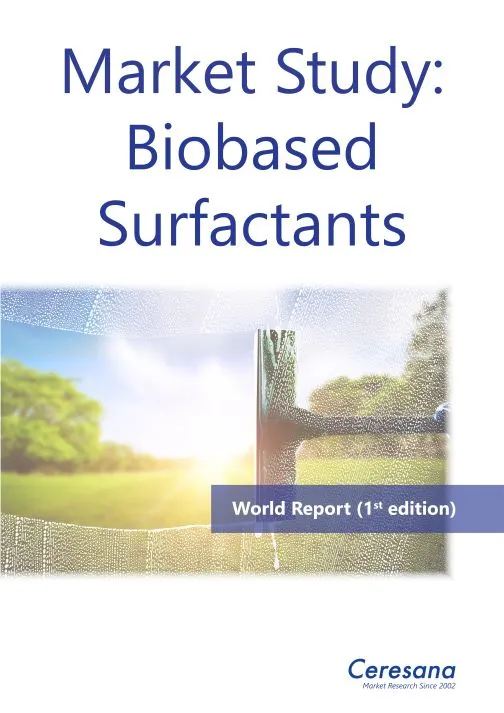Biotechnology for the bathroom: Household cleaners and creams are increasingly being produced using bacteria and fungi, more specifically the ingredients rhamnolipids and sophorolipids. But microorganisms in bioreactors are not necessarily the answer – traditional natural detergents are also being rediscovered, such as horse chestnuts or soap nuts. Surfactants are among the first everyday chemical products that are already being produced in large quantities not from petroleum but from renewable raw materials. Ceresana has studied the global market for surfactants produced in whole or in part from renewable biomass, i.e. based on sugar, fatty alcohol from vegetable oils or other biogenic material. The new market study forecasts that bio-based surfactants will reach global sales of around USD 34 billion by 2032. In North America and Europe, the market researchers expect growth of more than 3%, and in other regions of the world even more than 6%.
Biobased cleaning agents for households and industry
Surfactants enable water and oil to mix, they can form foam and facilitate the detachment of dirt. Washing powders and liquid detergents largely consist of surfactants. These chemicals are also used, for example, as emulsifiers in cosmetics, as dispersants in paints and printing inks, as antistatic additives in plastics and textile fibers, or as wetting agents in fertilizers and crop protection products. Surfactants can be found in toothpaste as well as in cooling lubricants, extinguishing foam, disinfectants and contraceptives. Industrial applications include the extraction of crude oil and the mining of ores. The most important sales market for biobased surfactants is household detergents and cleaning agents, which currently account for around 43% of global sales. They are followed by personal care products, cosmetics and industrial cleaning agents.
Sugar as an alternative to petroleum
All surfactants consist of a water-repellent and a water-attracting part, both of which can be biobased. Sugar surfactants, for example, can be composed of coconut or palm oil fatty alcohols and glucose or sorbitol. The properties of surfactants depend primarily on their electrical charge. Ceresana analysts expect the greatest growth for non-ionic surfactants, which carry no charge. These include alkyl polyglycosides (APGs), currently the most important sugar surfactants: They can be produced entirely from plants, are less sensitive to hardness than anionic surfactants, are already effective at lower temperatures and are considered to be more compatible with the environment and health. APGs could become an alternative to the surfactants that are still most commonly used today: the anionic linear alkylbenzene sulfates (LAS). They foam strongly and have high washing power but are produced from petroleum and are not fully biodegradable.
Biochemicals in a Cocktail
In the context of the bioeconomy and climate protection, the circular economy and green chemistry, biobased surfactants promise not only a reduction in the ecological footprint and greater independence from fossil raw materials, but also new recycling options for organic waste and by-products, for example from the paper and wood industry or biofuel production. However, whether surfactants damage the cells of fish or cause foam mountains on bodies of water depends primarily on their chemical structure and not on whether the carbon originally used came from fossil sources, carbon dioxide or biomass. Surfactants are often mixed with other chemicals, in detergents, for example, with complexing agents, which ideally are also available as organic versions. Mixtures of petrochemical and biogenic chemicals are marketed as “bioattributed”, “proportionately bio-based”, or “mass-balanced grades”.
The current market report “Biobased Surfactants”:
Chapter 1 of Ceresana’s new study provides a comprehensive analysis of the global market for biobased surfactants – including forecasts up to 2032: the development of demand (in tonnes) and sales (in USD and EUR) is outlined for each of the world regions. Demand for and revenues generated with biosurfactants are also broken down for each of the application areas. Demand is recorded for various product types: anionic surfactants, cationic surfactants, non-ionic surfactants, other surfactants. In Chapter 2, the market for surfactants is examined individually for 25 countries. Demand for and revenues generated with biosurfactants are presented in each case. In addition, consumption and sales are broken down for the following applications: detergents and cleaning agents, industrial cleaning agents, personal care and cosmetics, textiles and leather, paints and plastics, other applications. Chapter 3 provides company profiles of the most important biobased surfactants manufacturers, clearly arranged by contact details, revenues, profits, product range, production sites and brief profile. Detailed profiles are provided by the most important 59 manufacturers, e.g. BASF SE, Clariant International Ltd., Croda International PLC, JiangSu WanQi Biotechnology Co., Ltd., Kao Corporation, Nouryon Chemicals Holding B.V., Stepan Company, and Wilmar International Limited. Further information about the market study “Biobased Surfactants”: https://ceresana.com/en/produkt/biobased-surfactants-market-report-world

About Ceresana
As one of the world’s leading market research institutes, Ceresana specializes in the chemicals, plastics, packaging, and industrial goods sectors. Special focus areas are bio-economy and automotive / mobility. Since 2002, companies have benefited from high-quality industry analyses and forecasts. Over 250 market studies provide more than 10,000 clients around the world with the knowledge base for sustainable success.
More about Ceresana at www.ceresana.com
Ceresana
Mainaustrasse 34
78464 Konstanz
Germany
Press Contact: Martin Ebner, m.ebner@ceresana.com
